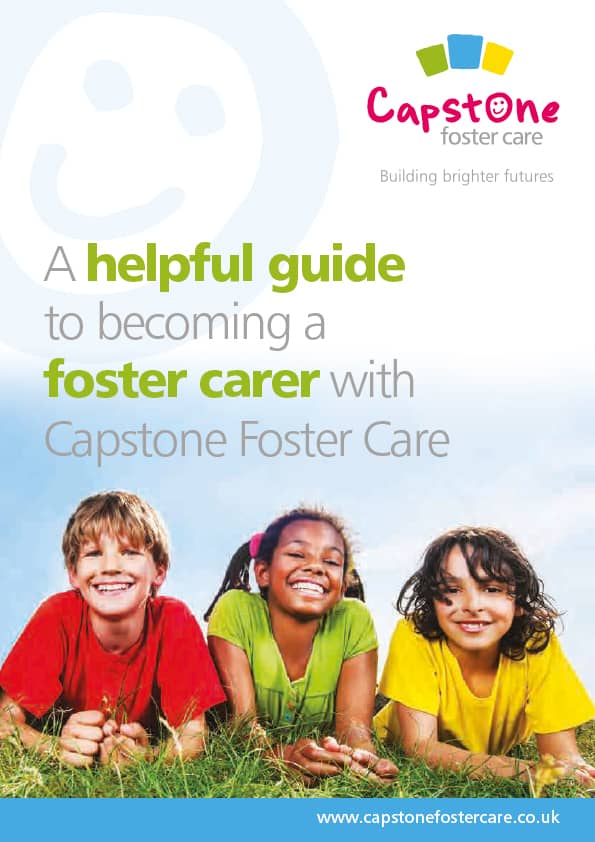


Fostering a disabled child
The role of an independent fostering agency
Can I choose who I foster?
How to foster
What are the benefits of fostering with an independent fostering agency?
What happens when a child is taken into care?
Fostering process: what happens on an initial home visit?
Can you foster if you have mental health issues?
Fostering with local authority vs independent agency
Interview: Life as a foster parent during the pandemic
Becoming A Foster Carer
Benefits of becoming a foster parent
What is a Care Leaver?
What is a Foster Carer?
What is Foster Care?
Do I become a Foster Carer?
Fostering Regulations
How much do Foster Parents get paid?
How to Foster a Child
How long does it take to become a Foster Carer?
How to foster – everything you ever wanted to know
Facts about Foster Care
What are the Foster Care requirements?
Foster Care Handbook
Foster Carer Job Description
Changing IFA - Transferring to Capstone
Fostering Definition
Foster Care Statistics
Fostering Assessment
Fostering Outcomes
Fostering Stories
Fostering Children UK
Children needing Fostering
8 reasons why a child may be taken into care
Fostering as a Career
Looked after Children
Top transferable job skills to become a foster carer
Fostering as a same sex couple
Fostering while renting
Can I foster if...?
Mythbusting the top 10 Foster Care Myths
Can I foster if I am disabled?
LGBT Fostering Mythbusting
Can I foster if I have pets?
Can I Foster A Child?
Can you Foster and Work?
Can you Foster with a Criminal Record
Fostering as a Single Parent
LGBT Family and Foster Care
Fostering across Cultures
Muslim Fostering
Christian Foster Care
Sikh
Empty Nest Syndrome and Foster Care
10 things you can do when your Children fly the nest
Can I Foster?
Fostering Babies - Myths
Focusing on Parent & Child Fostering
Fostering Siblings
Fostering Teenagers
Fostering Teenagers - Breaking down the Myths
Fostering Unaccompanied and Asylum Seeking Children
Mother and Baby Foster Placements
Private Fostering
Therapeutic Fostering - Multi-disciplinary Assessment Treatment & Therapy Service (MATTS)
Young Children Fostering Placements
Difference between short and long-term fostering
How to prepare a child for becoming a care leaver
Children who foster: impact of fostering on birth children
How to prepare your home for a foster child
10 tips for foster children’s education
How to prepare your foster child for secondary school
Tips for coping when foster placements end
Tips for foster parents during Coronavirus
What happens if foster parents get divorced?
5 ways to manage Mother’s Day with foster children
Tips for managing foster children’s bedtime routines
How to handle foster child bullying
Fostering allowances and the gender pay gap
Tips for keeping foster children safe online
How to adopt from Foster Care
5 ways to manage Father’s Day with foster children
8 most common fostering challenges
Supporting foster children’s contact with birth families
How to deal with empty nest syndrome
How to recognise signs of depression in foster children
Can you take a foster child on holiday?
Tips and advice on fostering with a disability
10 tips on connecting with your Foster Child
Fostering versus Adoption - What's the difference?
How Fostering can change a future
How to adopt from Foster Care
How to encourage children to read in Foster Care
How to prepare a Foster Child's bedroom
Online grooming - unwanted contact and how to identify it
Reading and storytelling with Babies and young Children
Supporting Children's Learning
Technology and Internet Safety advice
The 20 most recommended books Foster Carers and young people should read
The impact of early childhood traumas on adolescence and adulthood
Tips for coping with attachment disorders in Foster Children
Tips for supporting reunification in Foster Care
Together for a better Internet - Web Safety for Foster Children
What is sexual abuse and sexual violence
Foster Child behaviour management strategies
Foster Parent Advice: What to expect in your first year of fostering
Capstone's twelve tips at Christmas
10 celebrities who grew up in Foster Care
Celebrating our Children and Young People
Could Millenials be the solution to the Foster Care crisis?
Do you work in Emergency Services?
Form F Assessor and Assessment Training
Foster Care Fortnight
Improving Children's Welfare - Celebrating Universal Children's Day
It's time to talk about Mental Health and Foster Care
New Year - New Career - Become a Foster Carer
Promoting the rights and wellbeing of persons with Disabilities
Refugee Week
Young people and Mental Health in a changing world
Young People Charities
This is the day when the world shares the biggest celebration of children and young people with care experience. Care Day is about bringing the stories of carers and the care experienced into the public arena. If public attitudes on care experienced people’s lives can be shifted, it would extend the love and caring that sustains fostering and foster children beyond childhood.
Care experienced people are not separate from the public at large. They would benefit from an appreciation of their success in life. Most people know just enough about foster parents and children in care to have a basic understanding of the process. What may not be well known is the number of children in care in the UK and the number of amazing people who become foster parents to these thousands of children and young people.
The Fostering Network lobbies for improved child welfare, education and training. The Network also lobbies for improved regulations regarding adoption and foster care. According to their recent statistics, on any given day there are more than 65,000 children living with nearly 55,000 foster families across the UK.
The overall numbers are higher. 65,000 children in foster families represents just under 80% of the 87,000 children who are in care on a daily basis in England, Scotland, Wales, and Northern Ireland. Looking specifically at the statistics from government departments and bodies for England, on 31 March 2018, there were 55,200 children in England living with foster families.
This is 73% of the 75,420 children in care looked after away from home, or about 1% of all children in England under the age of 18. Each year, there is an increase in the number of children in care. In 2017-2018, there was an increase of 4%. In England, there are approximately 43,710 foster families. 6,800 more foster families are needed to meet the demand for fostering.
As well as 75,420 children and young people in care in England, there were 2,334 in care in Northern Ireland and 5,252 in care in Scotland in 2018. Using 2017 data, there were 4,434 in care in Wales.
This is a large number of young people who grow up and enter adulthood with experiences that they can share with their communities in a celebration of their outcomes in life. Care Day is a way for them to celebrate and share their joy.
Who are these 75,420 children in the care of local authorities? The most recent statistics in England are from 31 March 2018 and they show that 56% of these children were boys. Most of them (39%) were between 10 and 15 years old, 23% were 16 or over and 19% were between 5 and 9 years old. Of the rest, 6% were under a year old and 13% were between 1 and 4 years old.
Ethnically, 77% were white, 9% were of mixed racial background, 4% were Asian or Asian British, 7% were Black or Black British, 2% were from other ethnic groups, and 1% did not provide information.
On that day in March, 75% of the children and young people were living with foster carers, 9% were living in secure units, children’s homes or hostels, and 5% were placed with their parents. Another 5% were placed for adoption, 3% were with another placement in the community and a 3% were in residential schools or other residential settings.
The annual snapshot that is taken on 31 March is a typical day in the fostering world. There is a small variation from day to day, but the overall numbers remain more or less the same. This is why on average, the statistics report that 73% of the children in care are placed in foster homes but on that day, there were 75% in foster homes.
Over the course of a year, there are fluctuations because there are about 32,000 children and young people who leave foster care because they return to their families, are adopted, or they age out of care. There is a similar, slightly larger, number entering care each year.
One of the challenges is that there are never enough foster carers for all the youngsters taken into care. Another challenge is having the right type of foster carer available. There is no one size fits all when it comes to the needs of children.
It is the local authorities who take the young people into care and arrange for placements. They place two-thirds of the children and young people with their own foster carers. Independent fostering agencies, of which Capstone Foster Care is one, contract with local authorities and provide foster carers to the remaining third of the looked after children.
Foster carers come to us with various skills and abilities – and space. (Space is important because each child deserves, and must have, their own bedroom.) At Capstone, as with most authorities and agencies, we provide training and support. Foster carers are aware of the special needs of the youngsters waiting for placement.
Carers tend to specialise in certain types of fostering placement. For instance, children with disabilities and behavioural difficulties may need homes with specialist skills. Some carers provide short-term respite breaks for registered carers or for birth parents. Others may provide parent and child assessment care. Children being transitioned from short-term care to permanent families might be placed in a foster home during the transition.
As well as the types of foster care needed, there is another way to measure fostering placements and that is in the duration of the placement. Sometimes there is an emergency placement when a home is needed immediately while the birth family and the child’s needs are assessed. There are short-term placements, which can be quite short term, lasting for just a few days or weeks. A short-term placement could also last for several months or up to two years. The duration depends on the individual situation of the young person in care.
Long-term placements last until the young person becomes a care leaver. To put this another way, the placement lasts until the young person ages out of care at 18 years old. In the UK, there are about 10,000 care leavers each year. A care leaver could have been in care all his or her life, or they could have been in care for less than a year, which means that this would have been a short-term placement.
There are no cut and dried duration labels. What begins as an emergency placement can become a short-term placement which could become a long-term placement. Sometimes a long-term placement is referred to as a permanent placement. When a young person comes into care, there is a planning process that determines the child’s placement. Because all efforts are made to work with the birth family with the hope that the child will be able to return to his or her birth family, long-term placements are not necessarily determined from the beginning of the placement.
It is also possible that a long-term placement may not be considered a permanent placement. If there is a possibility that a child could return to his or her home, the decision to have a young person remain in care until he or she is 18 is not made even though that may be the way the placement turns out.
Over the duration of the placement, there is an ongoing assessment and usually there is a decision whether the placement will be permanent. At this point, there are further choices. A child who is permanently removed from the birth family home may enter into an adoption arrangement. Sometimes, the decision is made for the young person to remain in permanent foster care.
While it might sound confusing to highlight the way that a placement’s length can shift over time, there is a reason this is being described. It is important to know that fostering is flexible, and all decisions are made with the best interest of the child in mind. The need for flexibility demonstrates how special foster carers are. They go into the career of fostering knowing that they must be on hand immediately when needed without any guarantee of how long they will be needed.
Beyond fostering, there are programmes for care leaver, who are adults who have spent time in care before the age of 18. They could have been in care since birth or for just a few months until their 18th birthday. Foster parents often keep in contact with foster children after they age out of foster care.
Aging out does not mean that the young person turns 18 and that is the end of their support and care. Children’s Services continues to provide support and this support begins with planning for the future when the child is 15 years old. It’s called the Pathway Plan which provides plans for assistance with accommodation, higher education, spending money, and finding employment after they become 18.
Children’s Services is there to support care leavers until the age of 21. If the care leaver is in full time education or training or has a disability, Children’s Services will then support them until they are 21. Student support for care leavers is an essential part of the mandate to provide a better outcome in life. Sometimes the decision is made to arrange an extended stay with their foster family because of delayed maturity or vulnerability.
In addition to long-term, short-term, and emergency foster care there are other types of placements. Here is an overview of these types.
Remand foster care is an alternative to police custody. It is a specialised type of fostering where efforts are made to keep young people out of a police environment. Fostering is an opportunity for them to receive the care and space to think differently.
Therapeutic foster care can be long term or short term where the carers have specialised training and skills so that they are able to deal with challenging behaviours and mental health issues.
Parent and child fostering involves having a parent placed in foster care together with their baby or toddler. The parent can be the mother, father, or both. The foster carer is trained to assess the parental ability to care for a young child while also ensuring that the baby’s needs are met.
As you can see, fostering takes many forms with ever-changing needs. It provides a home framework for thousands of courageous young people with caring foster parents. Care Day originated in Scotland when the first Care Day took place in 2015. It was designed to commemorate the one-year anniversary of the Scottish Parliament’s unanimous passing of the Children and Young People (Scotland) Bill 2014.
In 2016, a joint initiative in the UK and Ireland across five children’s rights charities brought Care Day forward. These charities are Become (England), Empowering People in Care (Republic of Ireland), Voices from Care (Wales), Voice of Young People in Care (Northern Ireland), and Who Cares? Scotland.
The message of Care Day is “Get vocal, Get social, Get together, Get involved.” It encourages us to get together to recognise and celebrate the potential of children and young people in care.
It is the world’s biggest celebration of children and young people with care experience. The alliance of charities wants a world where the childhoods of these children and young people allow them to thrive and achieve their dreams. This enables them to achieve a future that is fulfilled, and of which they are.
If those who have been children in care can share and celebrate their experience and carers can tell their stories it can go a long way toward enabling education and change. The hope is that Care Day 2019 will “motivate the Care Experienced community, their allies and corporate parents to help love flourish in the lives of all Care Experienced people.”
It is a time to celebrate the shift of public attitudes on care experienced people’s lives.
If you’ve got any questions or would like to find out more about fostering with Capstone, fill out the form below.
An experienced fostering advisor from your local area will then be in touch.

Start the conversation today. Our team of friendly advisors are on hand to answer any foster care questions you may have. We can offer you honest and practical advice that can help you decide if becoming a foster carer is the right path for you.


